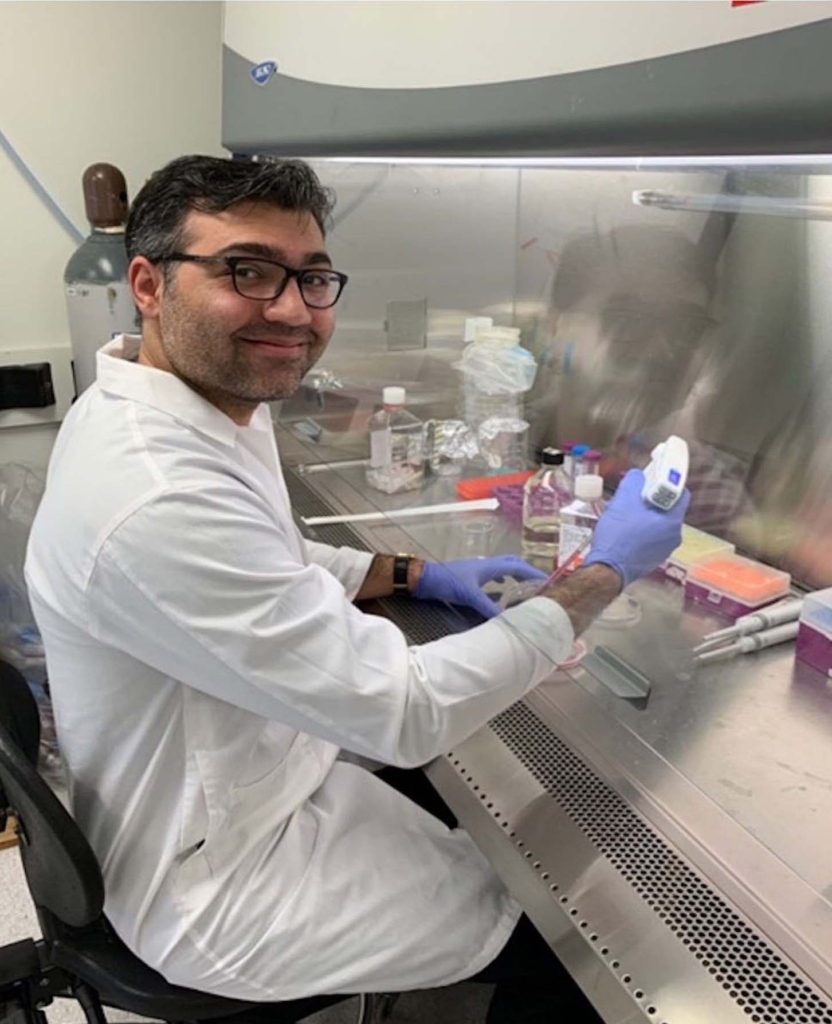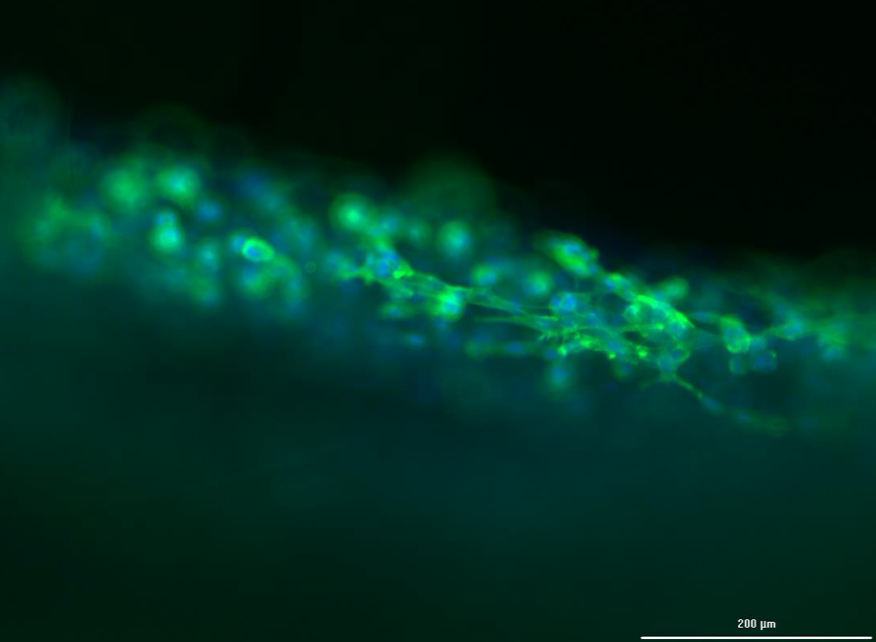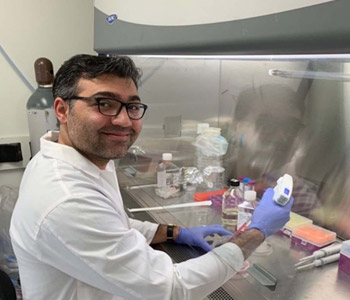Written by: Brian Cole

As a young university student in his native Iran, Javad Alizadeh was intrigued by the study of living organisms.
“From the very beginning, I was very interested in biology – how cells work, how they function. I was just fascinated by that,” he says.
As his interest grew, it seemed obvious that Alizadeh would pursue a career in science. By 2012, he was working on his Master’s degree at the Tehran University of Medical Sciences, one of the country’s top schools, and considering various options for the future.
Then tragedy struck.
Alizadeh’s father was diagnosed with colorectal cancer that same year and died three months later. From that moment on, Alizadeh’s interest in biology became more focussed. He decided that he wanted to dedicate his life to fighting cancer.
“If I want to name one particular motivation (for his decision to focus on cancer research), it would be the death of my father,” he says.
Alizadeh spent the next two years working as a research assistant at the Pasteur Institute of Iran, the most prestigious biomedical research centre in Iran, on projects involving colorectal and lung cancer. During that time, he also helped organize different events, including a conference on cancer research at the institute featuring scientists from around the world.
One of the presenters was Saeid Ghavami, an assistant professor and cancer researcher at the University of Manitoba. Ghavami spoke about the propensity of lung cancer to spread to other organs (a process known as metastasis), and how it might be stopped. Alizadeh was impressed, and, following the presentation, the two men had a chance to meet and exchange ideas.
“We kind of kept in touch after that,” says Alizadeh.
One thing led to another, and a few years later Alizadeh decided to apply for a student research position on Ghavami’s cancer research team. He was one of about 100 applicants for a position on the team, and one of only two to be selected.
“I (initially) had no intention to go overseas for studies,” he says. “But things got politically tricky (in Iran), and I thought, ‘Okay, it’s time to go to a more peaceful country.’”
That was in 2015.
Today, Alizadeh is one of Canada’s most promising young scientists, as evidenced by the fact that he recently won a 2020 Vanier Canada Graduate Scholarship, one of five at the U of M and about 160 across the country to do so.
The award, one of Canada’s most prestigious scholarships, is worth $150,000 over three years, and is given to students who demonstrate academic excellence, leadership skills, and an ability to carry out important research.
In Alizadeh’s case, the research involves a doctoral project that will examine factors that affect the spread of lung cancer cells to other organs in the body.
Needless to say, there is a tremendous need for research in this area. Studies show that as many as one in 12 Canadians will be diagnosed with lung cancer during their lifetime, with as many as 55 people dying from the disease every day. The risk of death increases if lung cancer spreads (metastasizes) to other parts of the body.
Ghavami says the Vanier scholarship is testament to Alizadeh’s passion and dedication to cancer research. Each scholarship candidate must undergo a rigorous review within their own university. Nominees are then assessed by a panel consisting of representatives from three federal agencies – the Canadian Institutes of Health Research, the Natural Sciences and Engineering Research Council, and the Social Sciences and Humanities Research Council.
“It’s very competitive,” says Ghavami, noting that Alizadeh scored in the top 20 among students applying for the award. “All of them represent the next generation of Canadian scientists.”
Studies show that as many as one in 12 Canadians will be diagnosed with lung cancer during their lifetime, with as many as 55 people dying from the disease every day.
Alizadeh’s doctoral research project, which also received a 2019 Research Manitoba/Rady Faculty of Health Sciences Graduate Entrance Scholarship, will build on the findings of a previous study he did as part of his Master’s degree in 2017. His Master’s research was supported by an award from Research Manitoba.
That investigation confirmed that the spread of lung cancer is preceded by a number of activities, including the transition of epithelial cells in the lungs to mesenchymal cells and a biological process called autophagy.
Among other things, epithelial cells in the lungs are responsible for immune response and injury repair. The transition to mesenchymal cells, known as the epithelial to mesenchymal transition or EMT, is required for normal lung development and wound healing.
However, Alizadeh says in lungs with cancer, this process means that as the epithelial cells transition, they also become “more migratory and invasive, which is a pre-requirement for the cancer cells to metastasize.”
Autophagy is a defence mechanism employed by normal cells to help clean up damaged components of a cell, such as organelles and proteins.
“It is like a cellular sweeper,” says Alizadeh. “Its mandate is to keep the cells healthy.”
But autophagy (the word is Greek for self-eating) also plays an important role in the life of cancer cells.
“Autophagy is a like a double-edged sword,” says Alizadeh. “Before a regular cell becomes cancerous, it acts as an anti-cancer mechanism by keeping the cells clean and getting rid of the damaged organelles and non-useful proteins. However, when (genetic or environmental factors) push that cell to become a cancer cell, then that cancer cell uses autophagy in favour of itself.”
The question in 2017 was whether the inhibition or induction of autophagy could reduce the spread of lung cancer cells to other organs in the body.
Alizadeh says that there are in the order of 32 genes that play a role in the autophagy. He also found that inhibiting the process, either chemically or genetically, would reduce the spread of lung cancer cells to other organs.
“What we found is that if we inhibit it, that would be better. Why? Because the inhibition of autophagy, both chemically or genetically, would basically reduce the ability of cancer cells to migrate, to move, to become more invasive.”
Of course, when it comes to cancer research, nothing is ever simple or straightforward.
While inhibiting autophagy can help reduce the spread of lung cancer, it is not a one-size-fits-all solution. “It depends on cancer type, cancerous stage, and tumour environment,” says Alizadeh.
He notes that the same type of study on brain cancer done in 2015 by other researchers found that inducing (as opposed to inhibiting) autophagy had the effect of stopping the spread of that particular tumour. “They found exactly the opposite of what we found,” says Alizadeh.
What this means, he says, is that there is no black and white answer to whether autophagy could or should be induced or inhibited to tackle cancer.
“Different cancer types use autophagy differently. You can also factor in different environments (for the tumour) – age, gender, everything.”
Alizadeh says his upcoming doctoral research project will build on his previous findings by exploring what role mitochondria play in the spread of cancer.
As he explains, mitochondria provide cells with the energy they need to function. “The mitochondrion in a cell is like an engine in a car,” he says.
As a result, mitochondria play an important role in powering cancer cells, which are known to require more energy than a regular cell to grow and spread.
Just as a cell can suffer damage, so too can the mitochondria. And, just like a cell, it can use a type of autophagy called mitophagy to help clean up the damage.
Once again, Alizadeh wants to know whether inducing or inhibiting mitophagy will have an impact on reducing the spread of lung cancer.

“The mitochondrion is the hub of the cell metabolism,” says Alizadeh. As a result, there are dozens and even hundreds of different interactions within the mitochondrion that could affect the spread of cancer. “Deep down, there are a lot of sub-pathways that could be affected.”
Moreover, there is the question of how efforts to target a cancer cell might affect a regular cell.
“That’s basically the worry… How selective is your anti-cancer agent. Is it only going to kill cancer cells? No. Why? Cancer cells are basically normal cells that have gone through carcinogenesis and have become cancerous. Therefore, they share a significant level of similarity with normal cells in terms of many different signalling pathways within the cell. So, when you inhibit this pathway (in a cancer cell) it’s going to (do the same) in a regular cell. You might kill the cancer cells by targeting that specific pathway but at the same time you might kill normal cells, too. Developing strategies to make our anti-cancer therapies more selective to cancer cells is one of the major challenges in cancer therapy.”
While the research project promises to shed new light on the proliferation and migration of lung cancer cells, it will also be noteworthy for how the work is carried out.
Typically, research of this type would involve experimentation on lab animals. But Alizadeh plans to carry out his work by collaborating with Adrian West, a research scientist at the Children’s Hospital Research Institute of Manitoba, to deploy a relatively new technology called 3D bio-printing. The technology will enable him to create artificial lung tissue that can be used to house cancer cells.
Basically, the process involves using collagen or alginate-based reagents to “print” a substance that essentially mimics human lung tissue. Lung cancer cells derived from patients are then placed in the artificial tissue, says Alizadeh.
While lab mice have a lot of genetic similarities to humans, Alizadeh says the 3D bio-printer can create a micro-environment for cancer cells that more closely resembles human tissue.
“The major component of the micro-environment in the human cell is collagen- or alginate-based, so it is very bio-compatible,” he says. “We can also incorporate other cells to even more mimic the real life tumour in lung tissue.”
A key benefit of using artificial lung tissue is that Alizadeh can alter its stiffness. Human lung tissue will vary in stiffness, depending on a number of factors, such as whether a person smokes. The question is whether changes in stiffness affect the spread of lung cancer cells.
“We want to answer how the stiffness of the micro-environment affects mitophagy, migration and metastasis of cells. And then we can manipulate mitophagy to see how that affects the ability of lung cancer cells to metastasize,” he says.
“By studying how removal of damaged mitochondria is regulated within these realistic lung tumours, I will get a better understanding of how we might be able to prevent metastasis in lung cancer patients,” says Alizadeh. “Our results may be an important step on the road to developing new treatments that target the removal of damaged mitochondria and prevent the escape of lung cancer cells to other organs. This will potentially reduce the progression of lung cancer in Canadians with lung cancer thereby increasing their life expectancy,” he says.
Alizadeh says he hopes to have his first research paper from the project out by the end of the year. Beyond that, he says his goal is to continue carrying out cancer research, preferably in Winnipeg. As he explains, he has grown fond of the city and is thankful for all the support he has received here, especially from University of Manitoba professors, Andrew Halayko, Adrian West, Tom Klonisch, Spencer Gibson and, of course, Ghavami.
“It (Winnipeg) has been my home for the last four or five years,” he says. “You always have to be flexible and open… (But) hopefully, after the training is over, I would like to come back to Winnipeg. I love Winnipeg. I love winter. To the extent that I can contribute to the Canadian scientific community, I would like to do that (here).”
Brian Cole is a Winnipeg writer.

